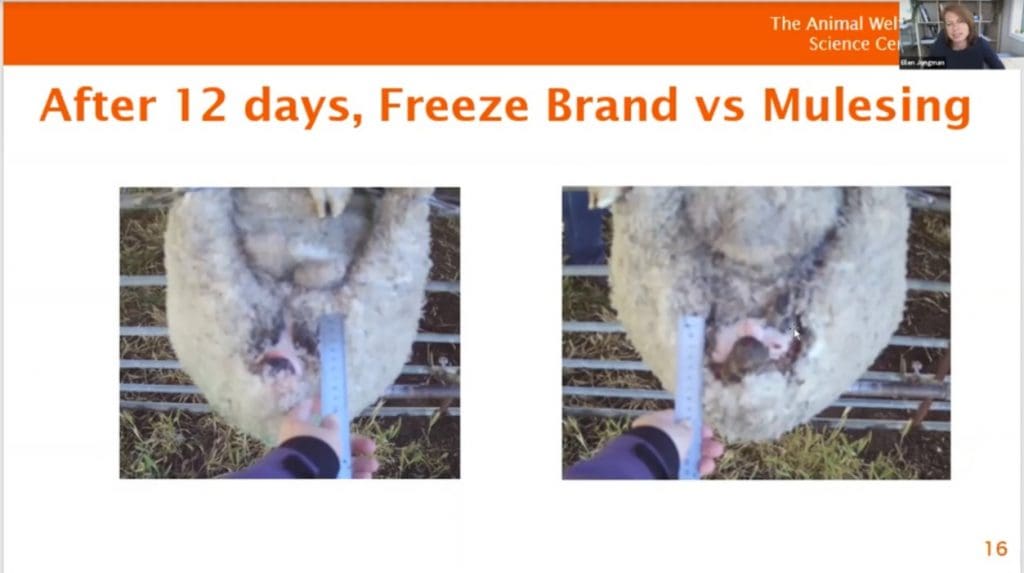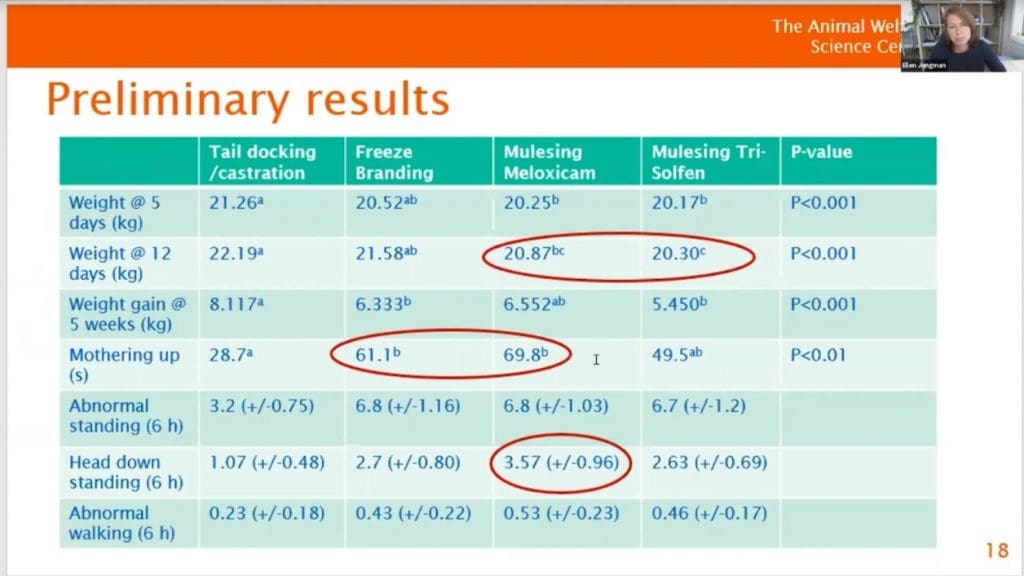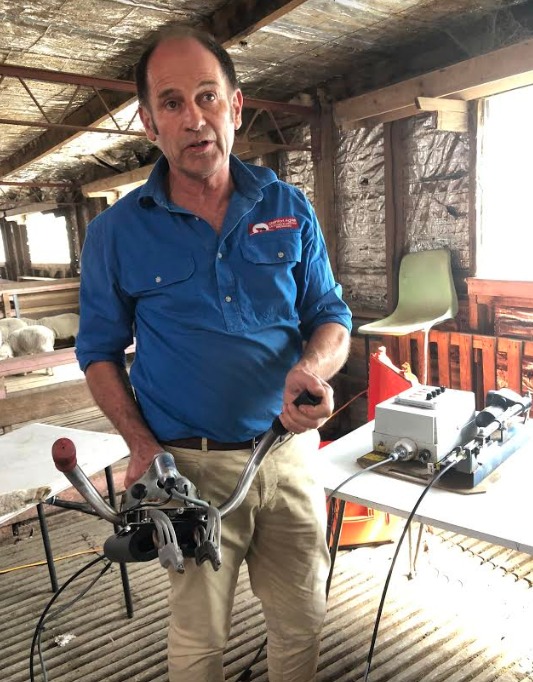
PRELIMINARY research results indicating sheep freeze branding is a painful procedure for lambs, even when using available pain relief, have been published by the University of Melbourne.
Sheep Central has learned that University of Melbourne researcher Dr Ellen Jongman released her preliminary findings on a sheep freeze branding field trial at a virtual forum on 2 December last year.
One of Dr Jongman’s preliminary conclusions was that freeze branding (with meloxicam pain relief) appears to be more painful than tail docking and castration alone, and similar to mulesing (with meloxicam), on the day of application.
“So it’s not a painless procedure and it may even be similar to mulesing on the day of application.
“But because there is no open wound, the pain and healing on the following days may actually be better for freeze branding; we don’t know that yet, there is still a lot of data that we need to analyse,” she told the 10th National Primary Industries Animal Welfare RD&E Forum.

The results showed that the mothering up time for Merino lambs treated with Meloxicam after freeze branding and mulesing was similar, but this was significantly slower than the time taken by mulesed lambs treated with Tri-Solfen.
“Whether the freeze-branded animals were in pain or whether it’s only the speed that it took to find their mothers, whether it’s pain or whether it’s discomfort, difficult to move, it is hard to establish from just this measurement, but it is often used as one of the measurements indicative of pain,” Dr Jongman said.
The research compared Merino ewe and wether lambs in four groups: 1. The control group – Tail-docking (hot iron) (+ ring castration of male lambs) with meloxicam injection; 2. As controls + liquid N2 application; 3. As controls + surgical mulesing, and; 4. Tail-docking (+ castration of male lambs) + surgical mulesing with Tri-Solfen application. There were 30 lambs per treatment.
Dr Jongman today told Sheep Central she was still finalising the data after doing a different analysis, but this wouldn’t change the results or her research conclusions.
“The numbers might have slightly changed, but the essence hasn’t.”
Dr Jongman believed further assessment of the bare breech area in adult ewes should be performed and more detailed measurements, including physiology, on the days following application should be taken in a more controlled study.
“I’m yet to finalise the final analysis and talk to AgVet Innovations to talk about further research.”
Latest results contradict earlier study

Sheep freeze branding developer Dr John Steinfort negelected to disclose existence of preliminary results.
The latest results contradict the results of a 2016 study on the website of AgVet Innovations, the joint venture company formed by freeze branding developer Dr Steinfort and wool broker AWN. That study concluded that freeze branding did not have a negative impact on lambs.
And despite the UniMelb trial preliminary results being known by freeze branding developer Dr John Steinfort, major industry bodies such as Meat & Livestock Australia, the Australian Wool Exchange and WoolProducers, and on the National Primary Industries Animal Welfare RD&E Strategy website for more than three months, no wider disclosure to the wool industry has been made until now.
Dr Steinfort told Sheep Central earlier this week that the COVID-19 pandemic had delayed the freeze branding research and it would not be completed least of all published and peer reviewed by the end of the 2021 NWD review. The veterinarian said “the last I’ve heard” was that the university was going through the trial’s assessments. He did not mention the preliminary findings or that they had been published on the NPIAW RD&E Strategy website.
Today’s disclosure comes just days after AWN pulled out of the AgVet Innovations venture and less than a week before the completion of AWEX’s latest National Wool Declaration review on 24 March. The review is focusing on the NWD with respect to mulesing status, with a particular focus on the identification of wool from sheep treated with liquid nitrogen or freeze branding.
WoolProducers president Ed Storey said he was aware of the preliminary research results by early January, but did not want to pre-empt the NWD review by commenting on whether they would change freeze branding’s status on the NWD.
“People are aware of that information.”
However, New South Wales wool grower Jim Gordon said the preliminary research results should have been released to the broader industry when they were first published. He did not believe industry stakeholders could make a valid submission to the NWD review without examining the research results.
“Definitely not; we need to know the full story.
“This smoke and mirrors stuff is giving me the shits, why can’t we get the truth about everything?
Dr Steinfort could not contacted for comment before this story was published today.
Click here to see a PDF of Dr Jongman’s presentation overheads.
Click here to hear Dr Jongman’s presentations with her preliminary results table. Her presentation starts at 54.39 minutes.

The board of AWEX and Woolproducers Australia look to have egg on their face yet again due to leadership that because of arrogance and a vested interest refuses to look at the bigger picture and a different future for our great industry.
Yes, those stud breeders that already have changed their breed type and don’t need to mules have a vested interest in change, but they know that the writing is on the wall and if we as an industry don’t change then we as a cottage industry will be the writing on the wall.
How can a country such as Australia that produces by far the best and most fine wool in the world be left looking so amateurish in the eyes of other wool-producing countries and more importantly to our valuable downstream customers?
A big thank you to Terry Sim for bringing this to light.
I wonder how much evidence we need to make change? This preliminary data reflects research undertaken by Australian Wool Innovation ten years ago. When, as a sheep industry, are we going to adopt technology, research results and respect customer sentiment?
The 2.67kg of body weight lost through breech modification is a massive economic loss. This 2.67kg body weight loss equates to 1.2 kg carcase weight at $8 per kilogram, which is a loss of $9.61 per lamb. This loss is the same for all first cross lambs that are mulesed – for no reason.
Other reasons for not mulesing: increased cost of mulesing – $1.20/lamb, increased cost for freeze mulesing – $6/lamb, mismothering to day 5, vulva distortions and reduced skin value.
Research has shown if we increase the breech and face cover it has a negative impact on number of lambs weaned.
At an industry sheep focus workshop on the 9th of April in South Australia the latest information and research on the impact of increasing follicle density to increase wool quality and production without impacting meat production or quality will be presented. Registrations for the day through Livestock SA.
Pain relief should be used for castration, tail docking and mulesing. This should be not negotiable.
All of this is not needed when it is possible to breed Merino sheep that are wrinkle-free, don’t need to be mulesed and are fly-proof.
The genetic solution will do this and at the same time produce more lambs and fast growing wool.
In addition, the market wants non-mulesed wool. That means no breech modification at all.
I just hope that the industry realises that it is possible to breed a modern Merino. Those that have moved to this type of sheep have no intention of going back to yesterday’s sheep. Ask yourself this question: ‘Do you still drive your grandfather’s car’?
Simply, the work has been done, it is possible to breed productive Merinos that do not need to be mulesed.
Surprise, surprise, and they thought muddying the waters was OK. It is never ever OK.